If you have not read the first part of this blog, you may want to read it – it covers the main differences between the projectors, 4K image sharpness & resolution, HDR color, calibration, and wide color gamut.
Black Level Performance and Contrast
Deep black levels in home theater give more depth and help make images appear more realistic. Of course, in a projector you can only have deep blacks if the projector is capable of good blacks – and the room and screen must be capable of supporting those blacks. When it comes to deep blacks, we have found no other projector to beat the JVCs. It also should be noted that in order to see the best blacks of any projector, the room must not only be dark, but not reflect the light that is generated on the screen from the projector. That means in order to get the very best blacks from any projector, the walls, ceiling, floor, and furniture must also be dark. Sometimes this is referred to as a “bat cave,” as the darker the room, the better the blacks can be in a projector.
Of course, not everyone wants a dedicated “bat cave” to watch their favorite movies or even some sports or other content. A good compromise is to have a mid-tone or dark-tone room. For example, I just re-did my home theater and the carpet is a deep black with some fun mid-tone designs, and the walls are mid-grey with some darker grey acoustic panels, and the ceiling is kind of a mid-grey blue acoustic tile. It has made a huge difference in my blacks and overall contrast, and I would highly recommend it if you want to improve your blacks and contrast. Unfortunately, our current demo room has not been redone yet and so the blacks do not give either projector their full capability. To measure contrast in such a room would not make much sense as the room is going to add to much light back onto the screen. It is, however, able to give us some idea of the comparative contrast and black levels.
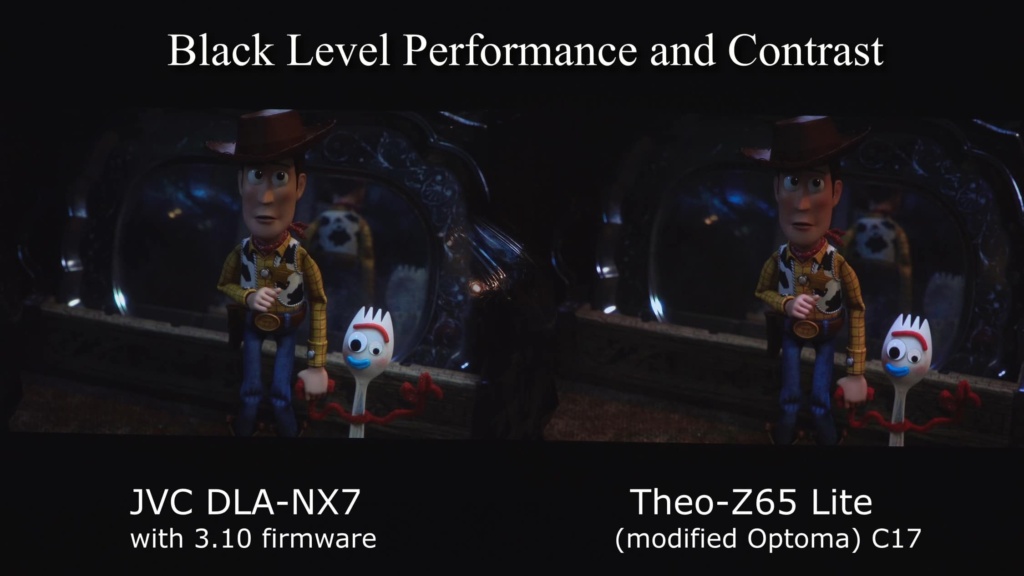
This image is how the camera captured the side by side above without overexposing highlights and clipping. Notice the fine detail on both images on Forky’s forehead just above his eyes – from Toy Story 4 native 4K UHD HDR disc.
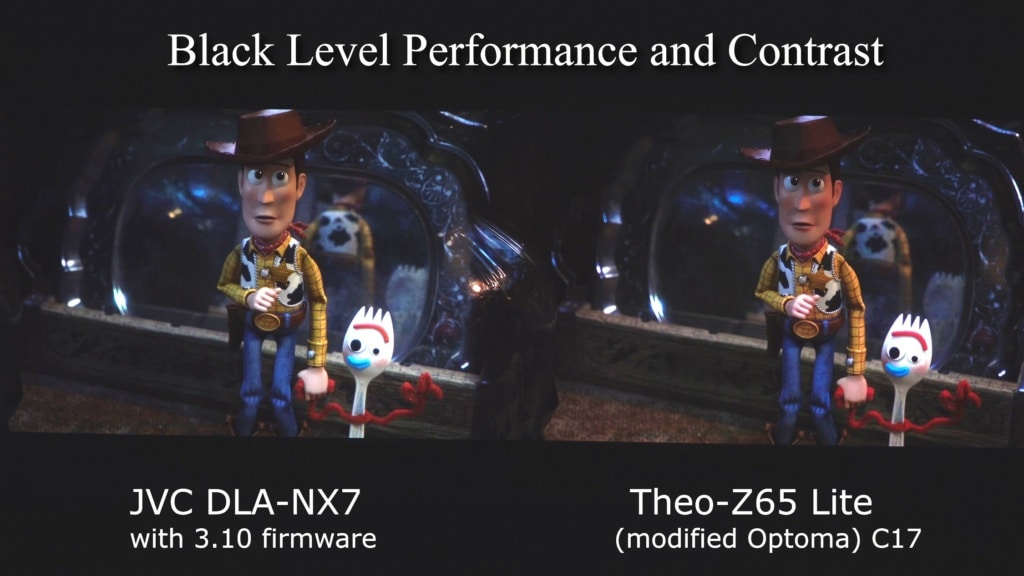
Same image as above but with additional gain and boost to the blacks equally in both images. The forehead is now more blown out to better show the comparative black detail and what it looked like in person, except we saw the images without clipping like the image above. (There is no real HDR for still images that we are aware of that most people would be able to take advantage of).
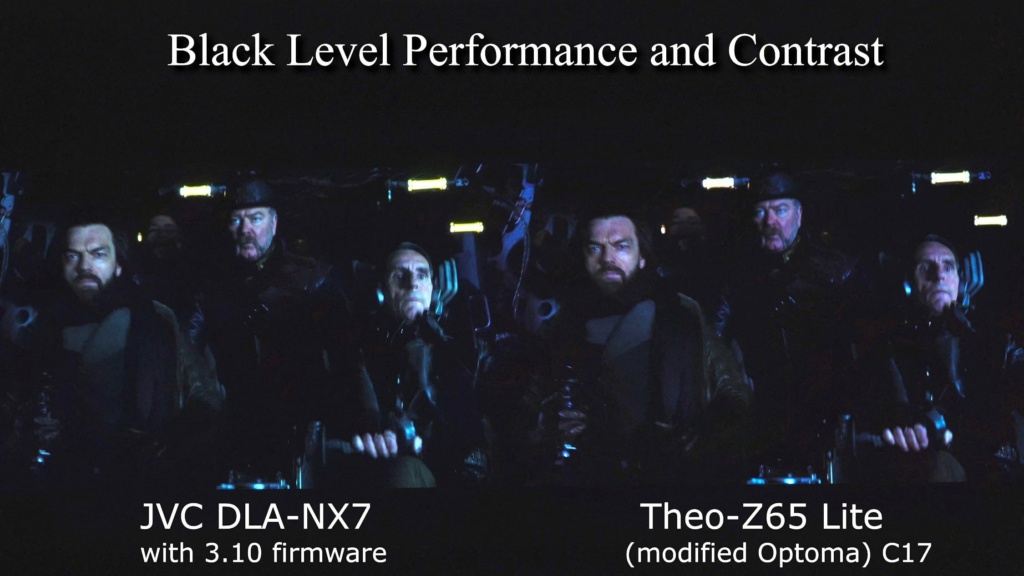
In this scene, from Mortal Engines 4K HDR disc, the differences between the tone mapping and calibration are more evident than any differences in real black levels.
On these kinds of images, low-level with some mid-tones, Kris pointed out that they are not really that low-level due to the mid-tones in the image. We have found, however, that there are many projectors that cannot equal the JVC blacks even on these kinds of images. If you look at these images very closely you will see there is no sign of poor blacks, or “milkyness,” in the images until you are well under the 10% average IRE like Kris brought with him from the Revenant (2015). One of the reasons the JVC can do so well on those ultra low light scenes is the JVC DLA-NX7 has dual iris capability which were both used during this comparison. One of the differences between the DLA-NX5 and DLA-NX7, besides the wide color of the NX7, is that the NX7 has both a fixed iris for best contrast and then the dynamic iris works on top of that to provide those incredible blacks.
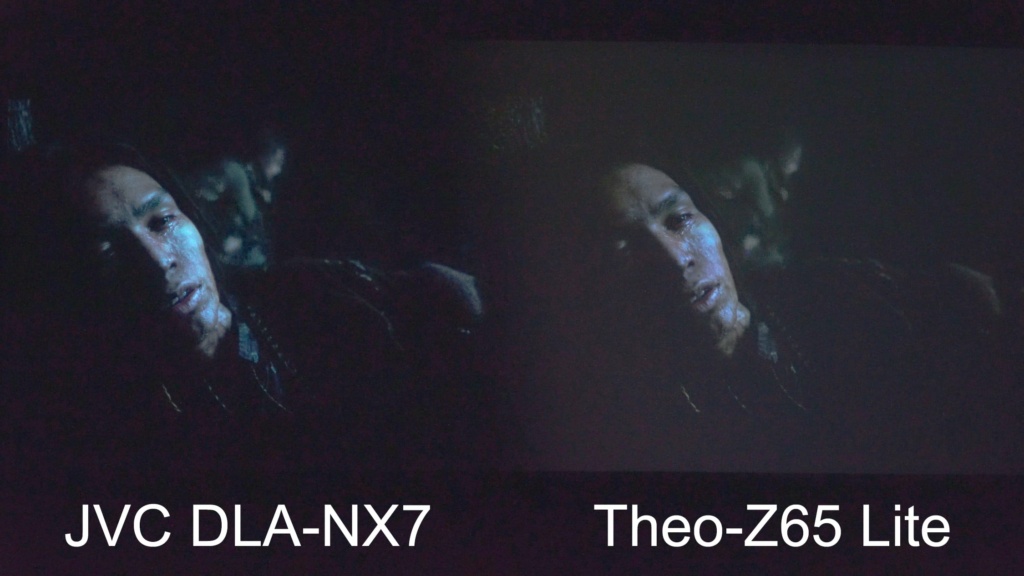
Here, on this almost- completely black or extremely dark image, you can see those deep blacks JVC is famous for. This image above has had additional gain and brightness added so you can better see the differences closer to what our eyes saw – but still not the same as seeing in person. Again, the frame-by-frame tone mapping is able to keep the JVC, even at these levels, keeping both the blacks and the near-blacks of the face more dynamic.
In addition to reducing the original Optoma UHZ65 projector brightness from 3,000 to about 2,200 lumens, we were also able to improve the blacks by reducing the reflections inside the light engine by reducing the amount of reflected light in the “off” state of the DLP light engine. In all DLP projectors, the off state or black is created by a typical 12 degree deflection of each mirror; since the light is still hitting the mirror, any reduction in reflected light inside the light engine will also lower the blacks. That is how we are able to significantly improve blacks by using both the filter and the light engine improvement. Here is a comparison of an unmodified Optoma UHZ65 shown side-by-side with the JVC DLA-NX7 and the Theo-Z65 Lite
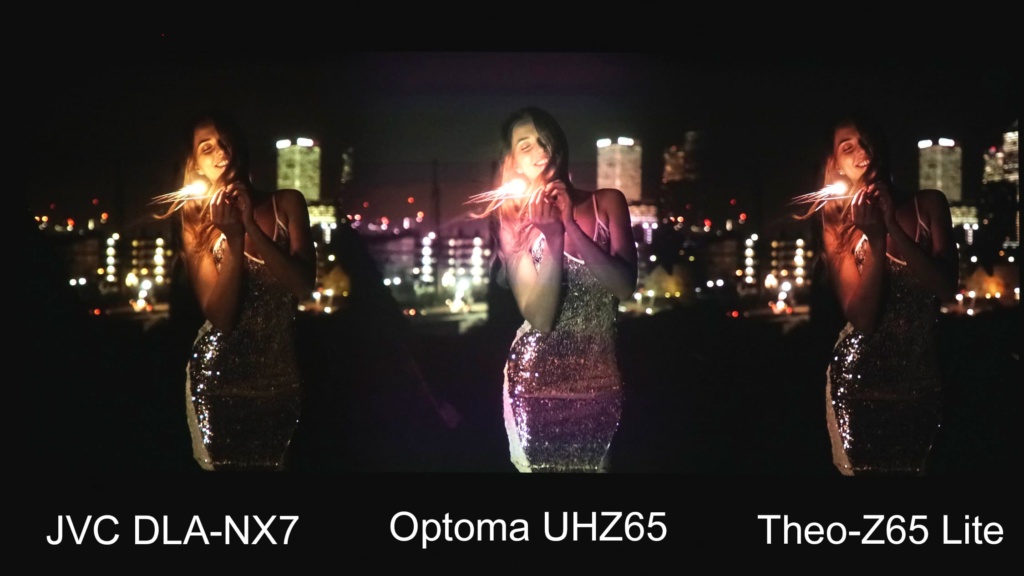
Note: Disregard the slight rainbow-ing caused by the shutter speed of the camera and the color wheel, which is not visible in person. Here, the Optoma is factory settings out of the box except the peak brightness was matched to the JVC and Theo. Notice the dark sky above each image and the differences.
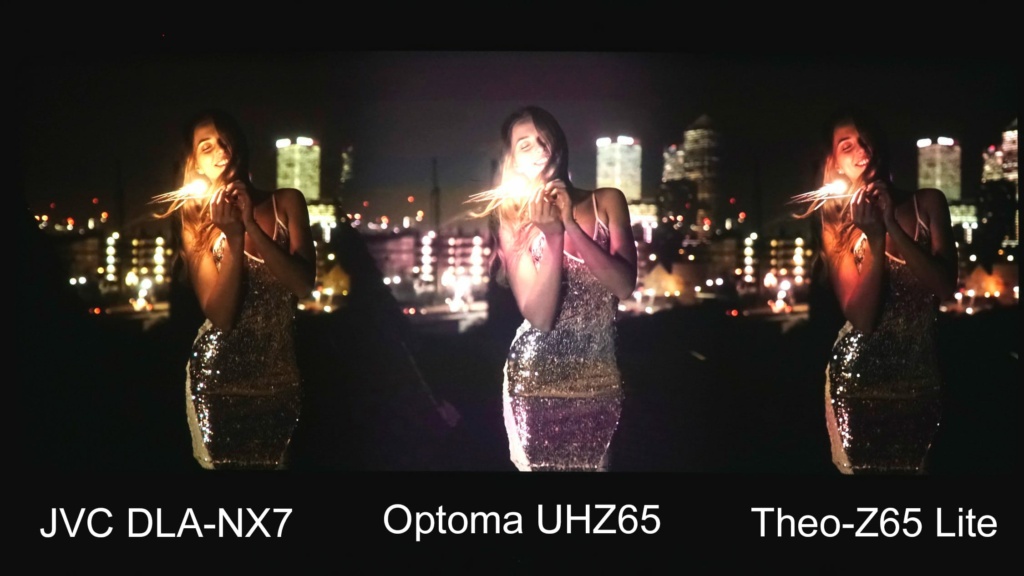
Same as above but with Dynamic Black 1 enabled on the middle unmodified Optoma UHZ65. This is how it is set at the factory and gives a significantly brighter image but with slightly raised black levels. Again, rainbows near sparkler are due to camera limitations and not visible in person.
Here are Kris Deering’s comments on the JVC DLA-NX7 and Theo-Z76 Lite comparison from the 4K HDR-10 disc from Diversified Video.
HDR Performance and HDR Tone Mapping
Well-executed and projected images in 4K HDR, from a 10-bit source (4K HDR UHD disc) in wide color, is an experience to behold. We enjoy doing demos with clips from movies that most people have seen, and it is a whole new experience for them as even in a commercial theater they do not have the brightness, detail, or dynamic range that we can now do in our homes! Even though these two very different projectors have unique ways of doing HDR tone mapping, they each have additional fine tuning of the HDR tone mapping, as Kris demonstrates in the comparison video of the JVC DLA-NX7 when he shows “Auto, Low, Middle, and High” adaptive tone mapping choices. Likewise, the Theo-Z65 Lite has four tone mapping choices on top of what we do with the original tone mapping. Those choices are “Bright, Standard, Film, and Detail”.
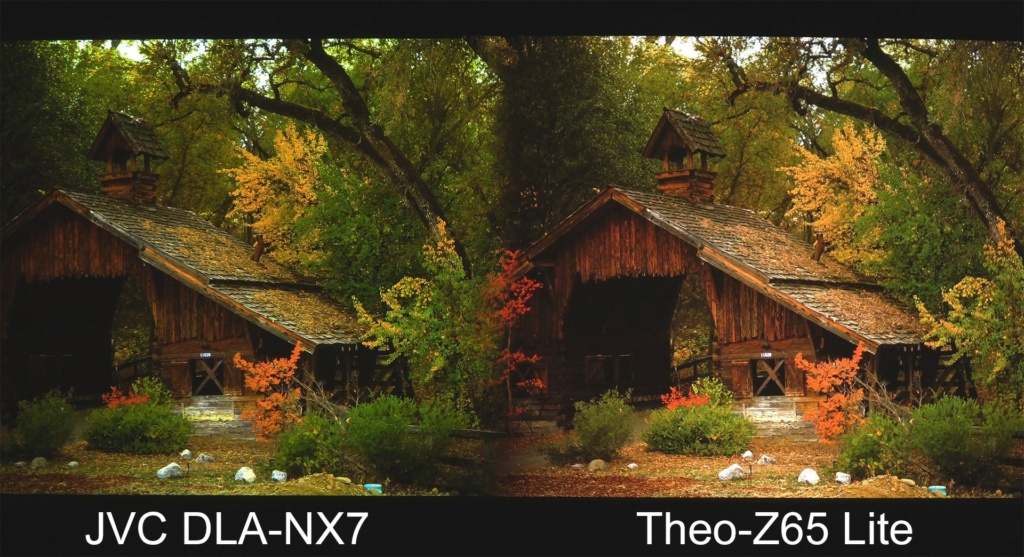
HDR test image from the HDR10 4K disc. Here, the JVC NX7 is in “Auto” adaptive tone mapping setting and the Theo-Z65 Lite is in “Film”. As mentioned in the video, we have modified the standard tone mapping in the Optoma to a bright mid-tone range to favor skin tones.
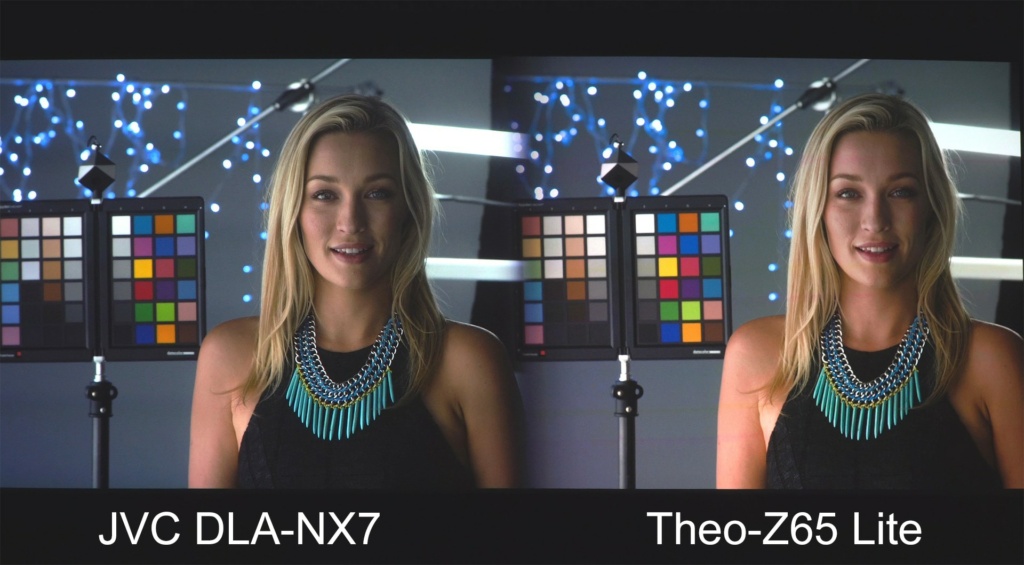
Reference 4K HDR skin tone image from the HDR-10 disc. Here you can see the results of our raised mid tones both in the skin tones and also in the color checker color chart behind the model. JVC on the left is in “Auto,” and the Theo on the right is in “Film” HDR brightness mode. This is also why we do a “Balance” type of calibration and exceed the P3 standard. The downside of our tone mapping is it will start to clip at an earlier level than the JVC as shown below.
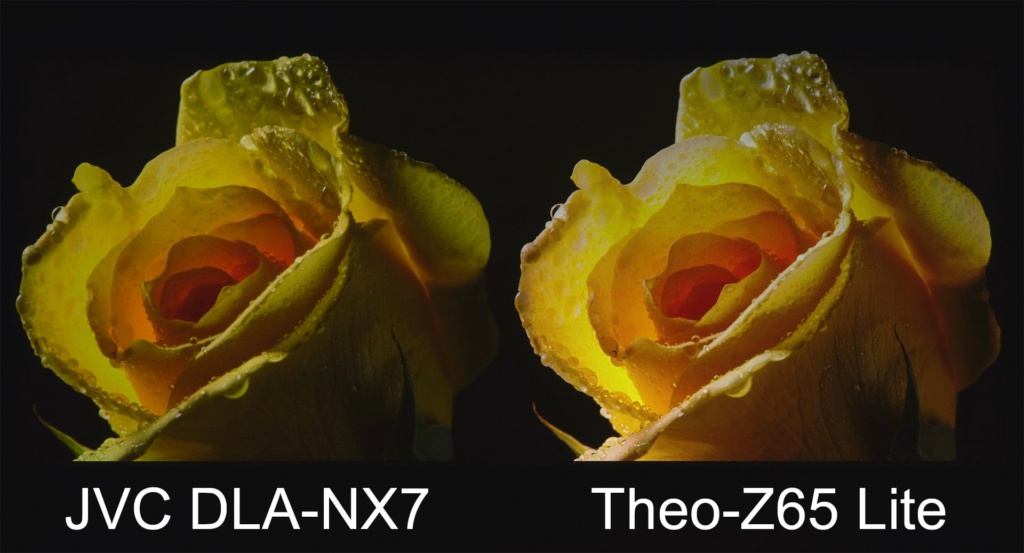
In this freeze frame from the new Spears & Munsil 4K HDR Benchmark calibration disc, you can see the highlight clipping on the right in the Theo – but with that you also get a brighter image. The JVC can be turned up to “High,” and the Theo could be turned down to “detail” HDR brightness, which would reduce the clipping as well as the brightness.
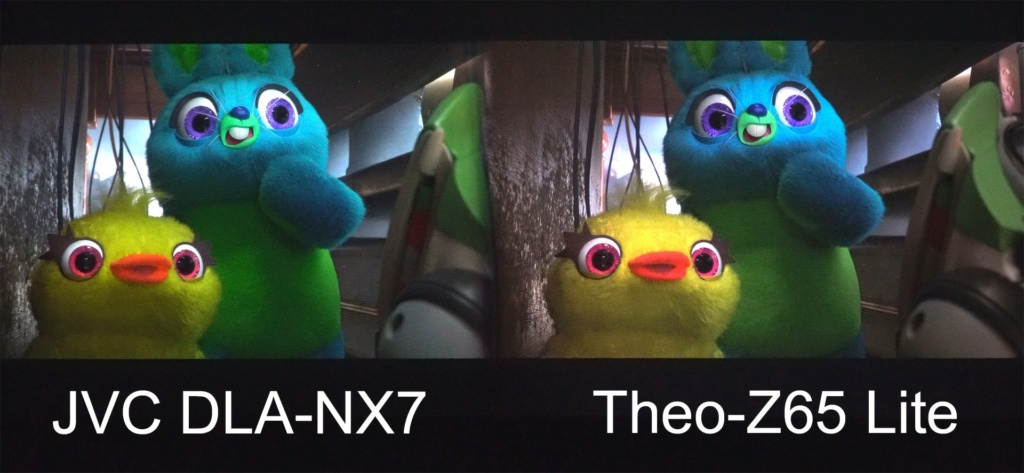
This freeze frame from Toy Story 4 4K HDR disc begins to show the dynamic tone ranges, color, and detail that combine to make 4K HDR an incredible experience. Both projectors deliver an amazing experience which really has to be seen in person to fully comprehend.
Extreme High Brightness HDR
As mentioned earlier, there are not fixed standards yet in HDR color grading at the studios. Most movies we have watched are graded at 1,000 nits, however it is possible for a studio to grade at 4,000 or even higher nits. This is where the JVC, with its Frame-Adaptive tone mapping, really shines. it is able to sample the the overall brightness levels and adjust the tone mapping for that scene or even frame.
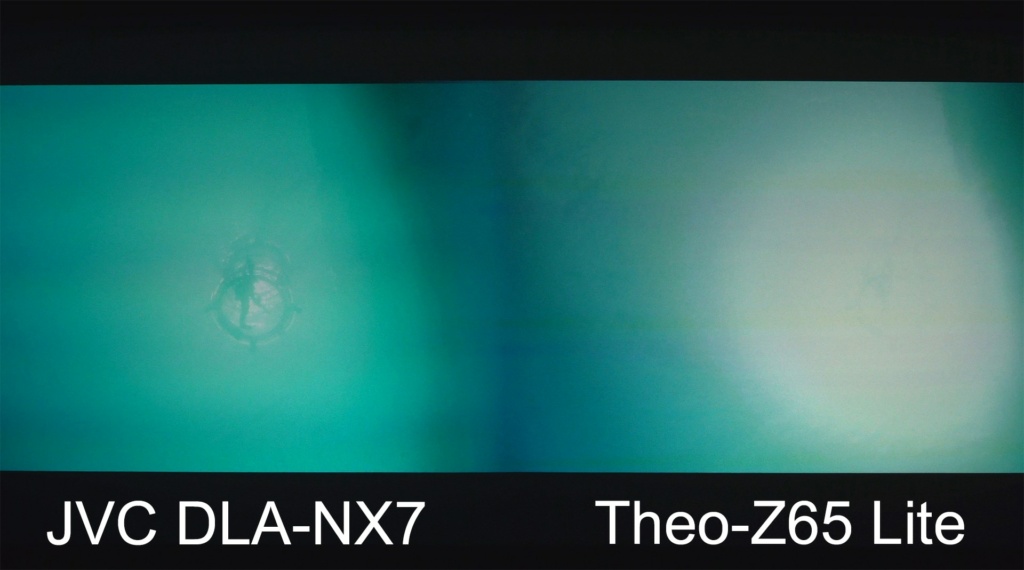
BEFORE: In this extremely bright scene (4,000 nit grade), the fine details in the sun coming through the diving cage from The Meg 4K disc are lost in the static tone map of the Theo on the right. We have since come up with alternative HDR settings for those movies that are graded with 4,000 nits and higher. Note: the horizontal banding and colors on both images are camera artifacts and not visible in person.
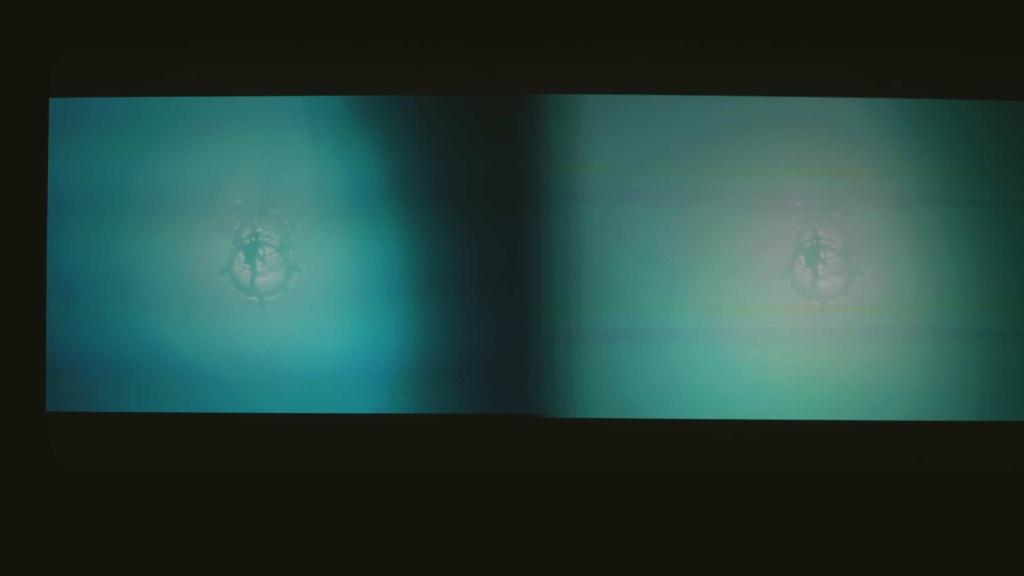
AFTER: Same scene as above, but now the Theo-Z65 Lite is in the new Extreme HDR brightness range (available to all Theo owners for extreme high brightness graded movies). Again, horizontal banding and color distortion is camera shutter speed and not visible in person.
Here are some additional scenes from the new HDR Benchmark calibration disk from Spears & Munsil and Kris’s remarks.
Conclusions and Results
This had definitely been one of the more interesting and challenging comparisons to capture. There is absolutely no substitute for seeing these live, however, that is not possible for many so we hope this comparison adds new insight and understanding. As we began and now re-affirm, this is not a projector shootout, this is a comparison between two very different technologies and between two different calibrations. The goal is to help show what a reference level projector can do and how the Theo-Z65 Lite compares in terms of 4K detail, color gamut, and HDR performance.
JVC DLA-NX7 w/ 3.10
Previously, we had rated the JVC DLA-NX7 the highest performance of any projector we have tested. With the addition of the new Frame Adaptive HDR (Dynamic HDR), the JVC further establishes itself as the leader in under $10,000 projectors. Kris was able to fine tune and get an even higher level of performance that was near perfection. If the JVC is in your budget, please call us at 801-486-5757 or contact us online and we will help with the purchase process and answer any questions you may have. We can also arrange for Kris to calibrate the projector before we ship it to you once we know your screen size and type. Please note that JVC has posted a warning on their website about counterfeit JVC products (even in the US) and has also noted that new Procision projectors are NOT sold online.
| Pros | Cons |
|
|
Additional things you may want to consider:
- Fan noise: ~34-37db in high bright mode
- Weight: 43.56 lbs
- Dimensions: 19-3/4″ x 9-1/4″ x 19-1/2″ (W x H x D)
- Standard 3-year parts & labor warranty
- 3D HD Blu-Ray Capability
Here is our updated Theo-chart for the DLA-NX7 w/ 3.10
TheoZ65 Lite (Modified Optoma UHZ65 Laser Projector)
What a privilege to be able to finally see the Theo-Z65 Lite side-by-side with a near perfectly-calibrated high performance projector – we just can’t thank Kris Deering enough. We are excited about our extra wide color gamut, good black levels and contrast, and for all but the most challenging scenes – a very good showing against one of the best. Considering the Theo-Z65 is under $5,000 and has a zero-maintenance 30,000 hour laser, we were very pleased with the comparison. We feel the Theo-Z65 Lite is the best “under $5,000 4K laser projector” currently on the market and invite you to visit more with us. We would also encourage you to take advantage of the “Projector Challenge” and come see the projectors in person. Please give us a call (801-486-5757) or contact us online so we can make sure we are here and have the staff available to help show you the comparisons.and the projectors you wish to see are available.
| Pros | Cons |
|
|
Additional things you may want to consider:
- Fan noise: ~29-33db in high bright mode
- Weight: 20.5 lbs
- Dimensions: 19-3/5″ x 13″ x 6″ (W x H x D)
- Standard 3-year parts & labor warranty (approved by Optoma)
- 3D HD Blu-Ray Capability
Here is our Theo-chart for the Theo-Z65 Lite w/ C17

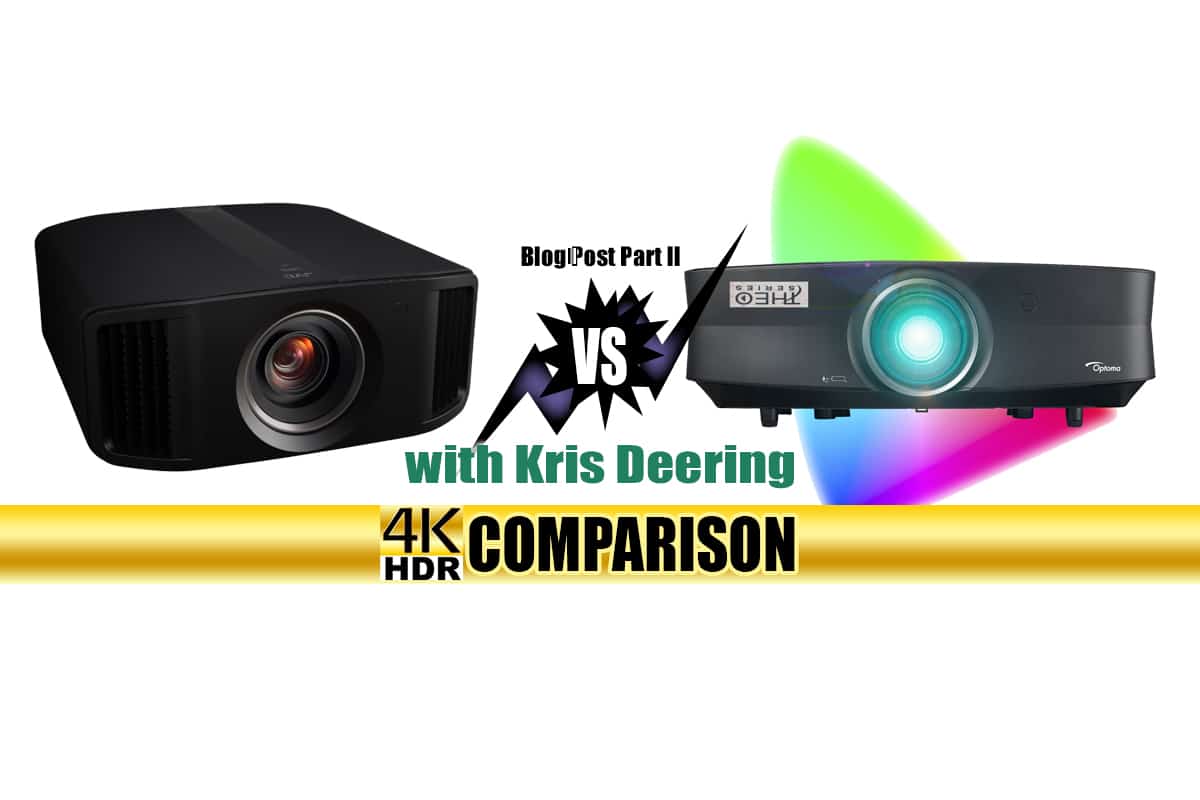
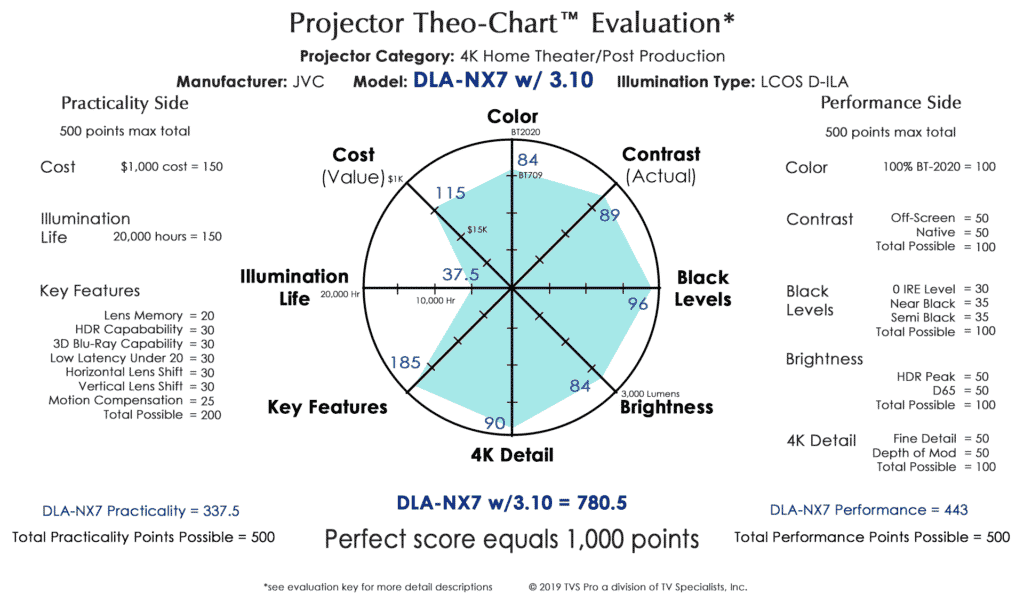
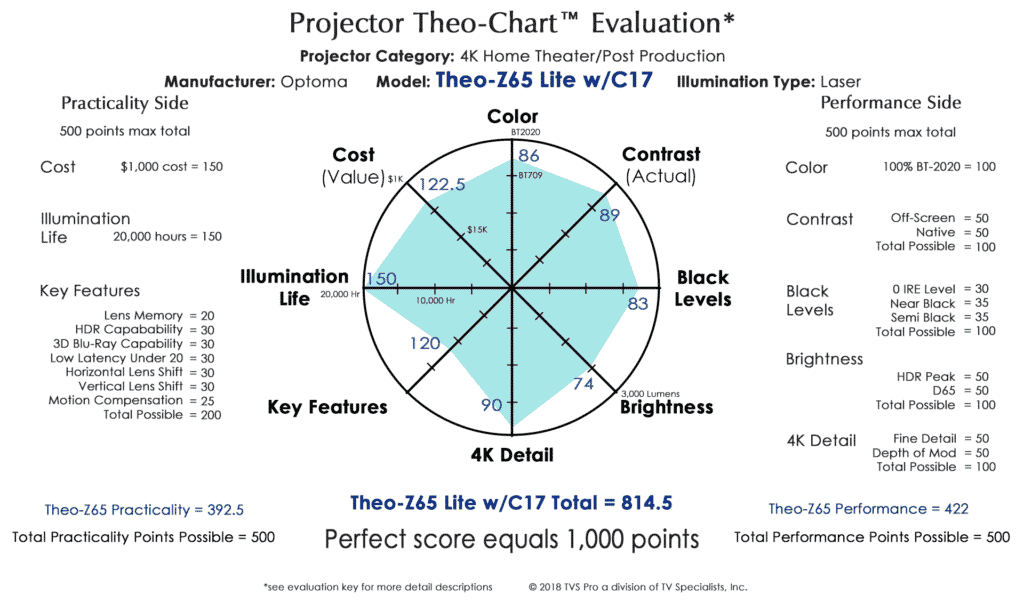
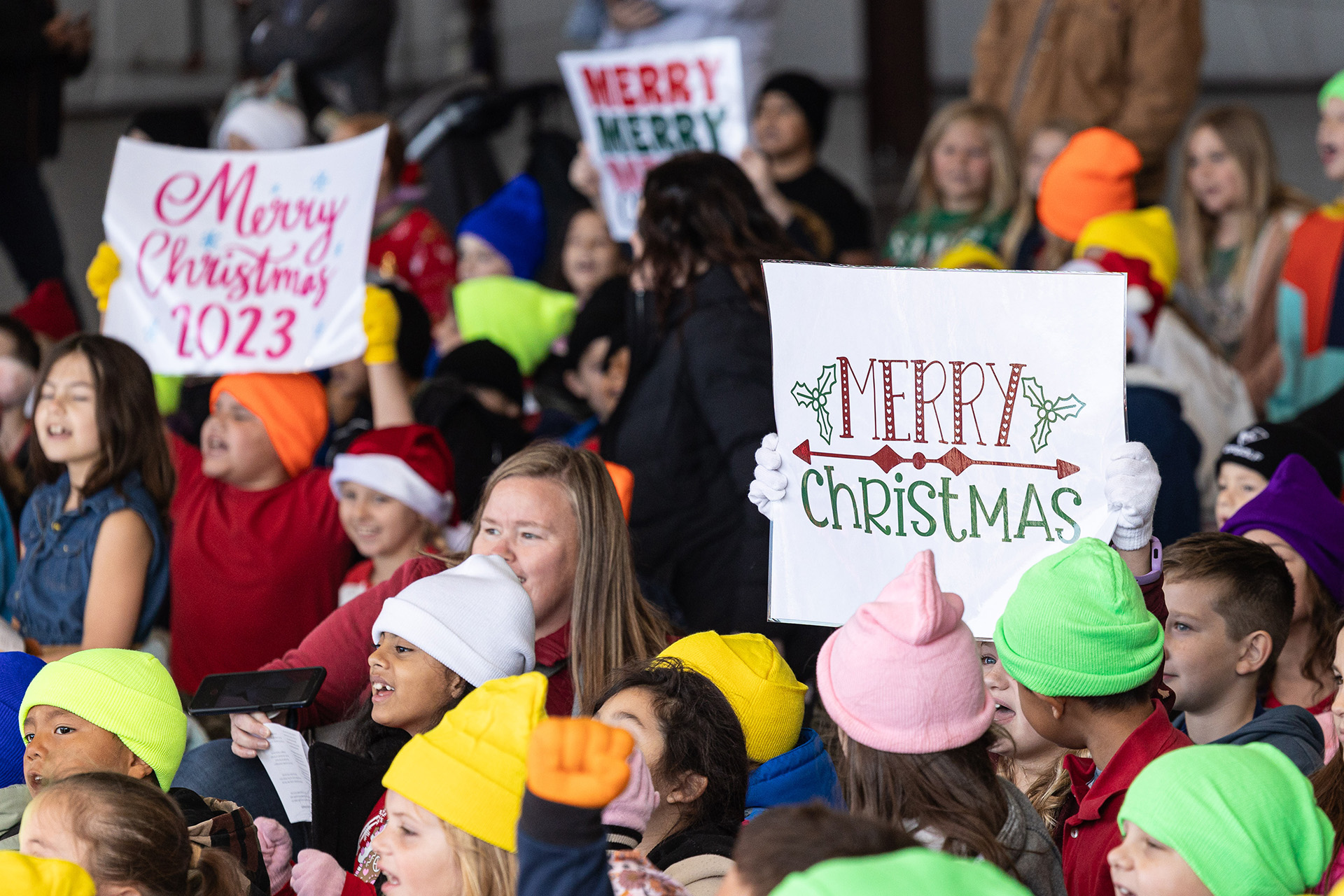
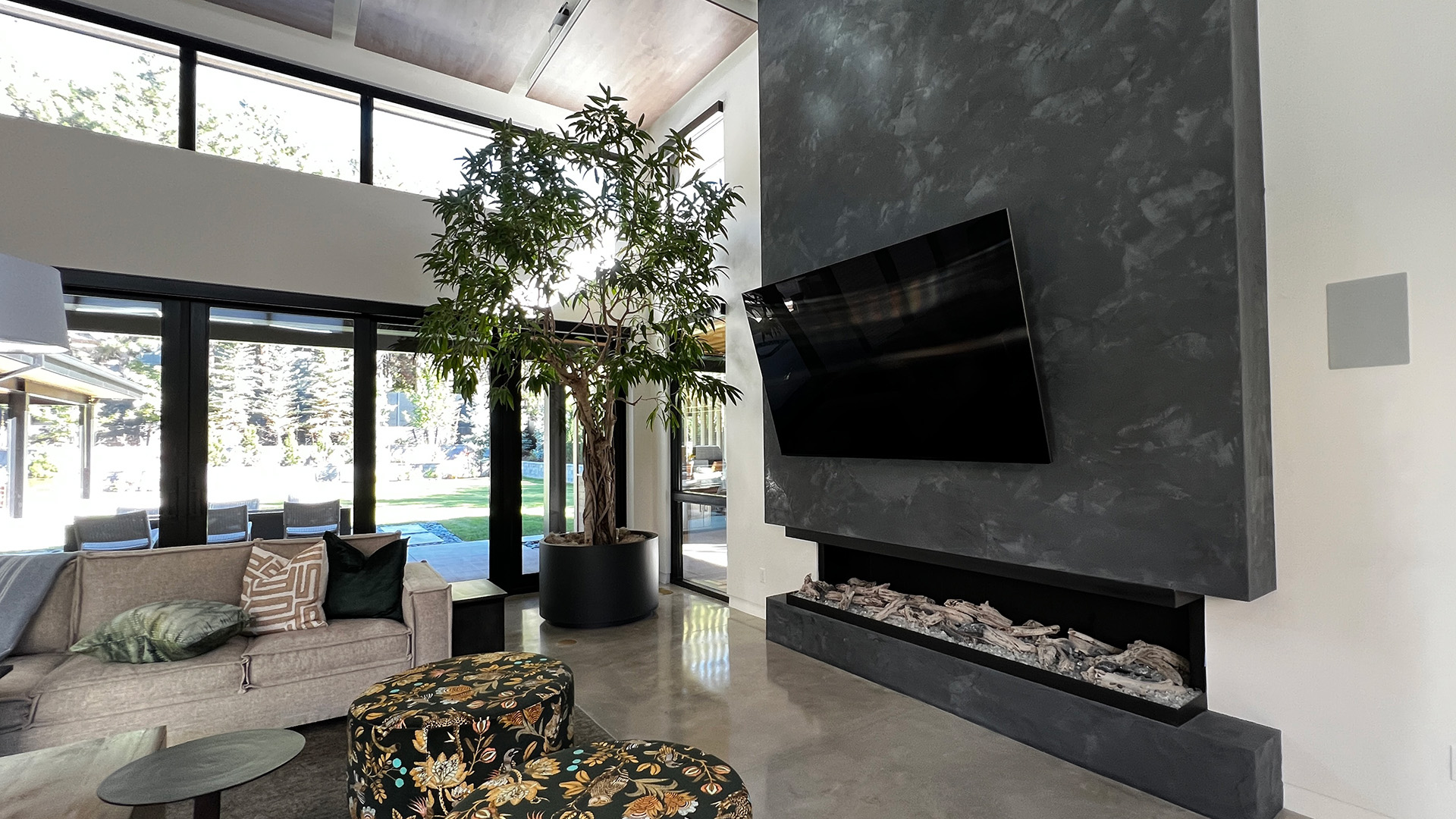
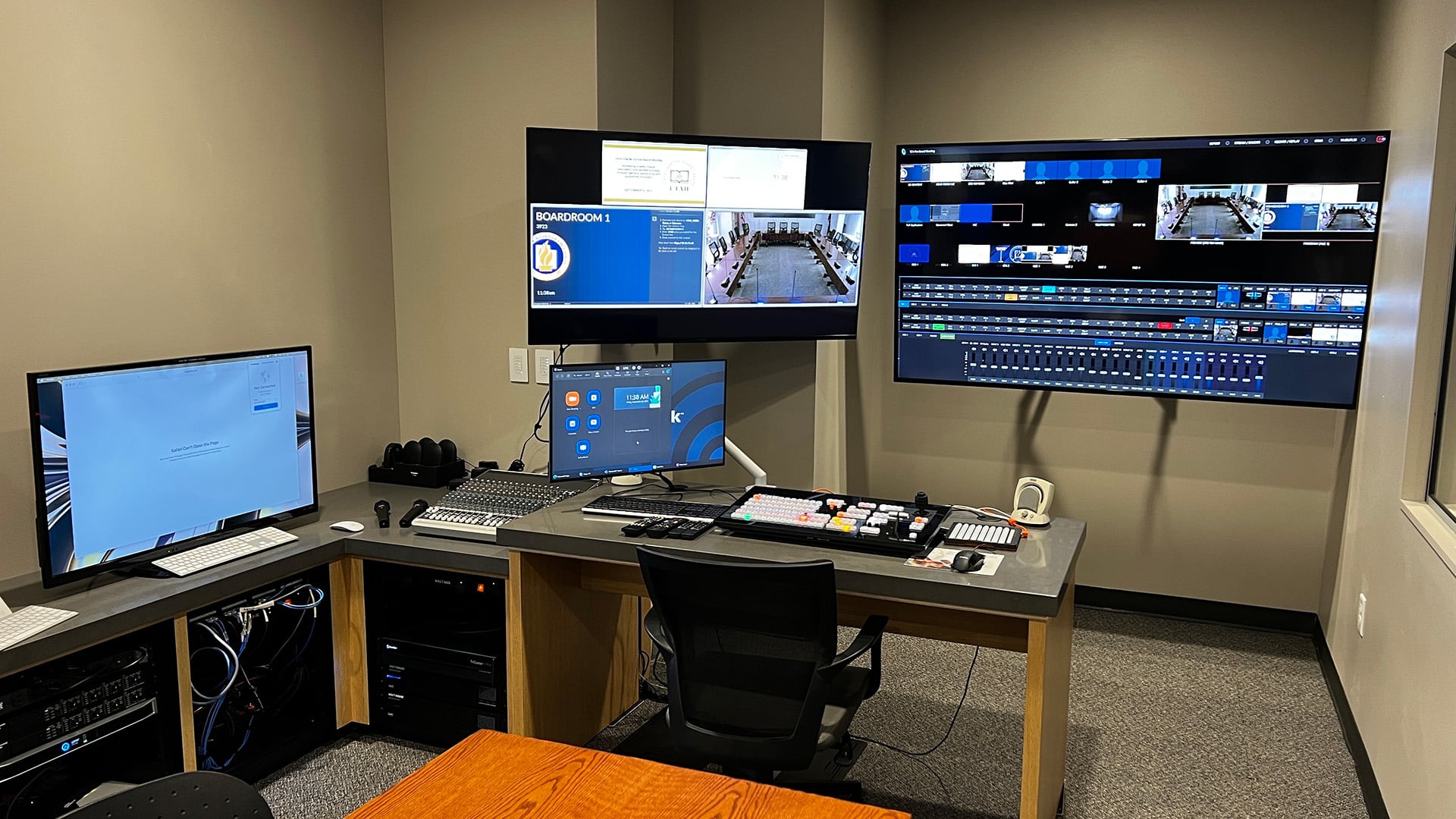
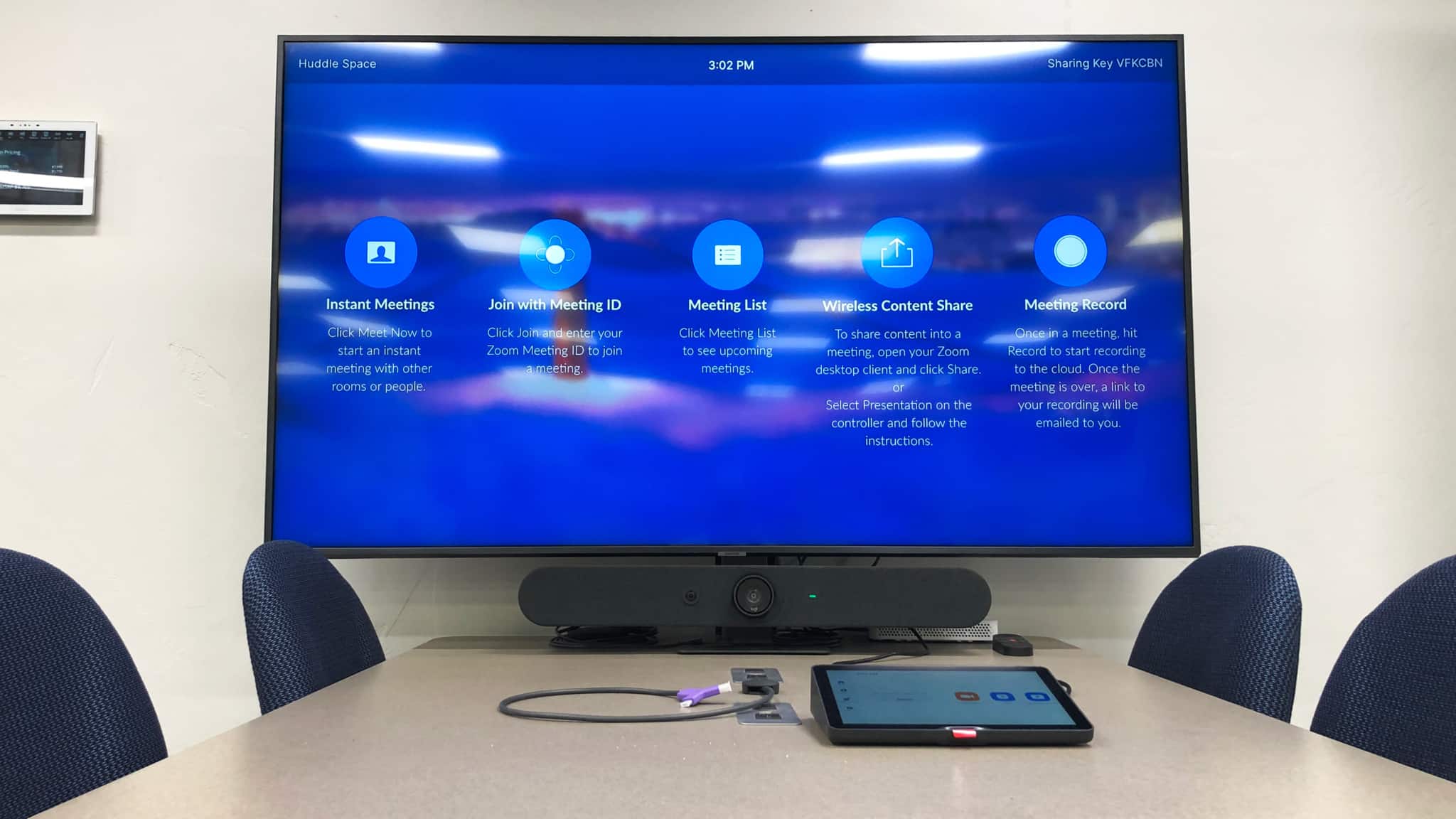
0 Comments